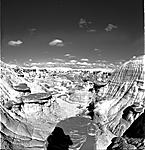[QUOTE=Heroique;902447]Thanks for the useful reference, Joseph.
For example, the Hutching’s Factor asks you to take a meter reading through the filter,
Reflected, not Incident if he meters through the filter.
[QUOTE=Heroique;902447]Thanks for the useful reference, Joseph.
For example, the Hutching’s Factor asks you to take a meter reading through the filter,
Reflected, not Incident if he meters through the filter.
I didn't realize this table was in the book (which I don't own) but the same table/system was posted in View Camera magazine years ago. I used it with medium format film and an in-camera averaging meter (Pentax 67). It worked very well in that context. But I was never very certain about its use with a 1 degree spot meter since the through-the-filter reading with a spot meter depends on the tone of the area (presumably very small) being metered. So with a spot meter I just used the filter factor and that too worked well.
Absolute precision or perfection in exposure is unlikely to be achieved with any system when using a filter for b&w photography. Fortunately b&w film has plenty of latitude so small "errors" are almost always unimportant. I used to make two exposures of everything, one at the meter reading and the other at one more stop than the reading indicated. Invariably either would have given a perfectly acceptable negative so I stopped that practice.
Brian Ellis
Before you criticize someone, walk a mile in their shoes. That way when you do criticize them you'll be
a mile away and you'll have their shoes.
Interesting discussion...
I had read, years ago, that there should be a one-stop difference with a 25a, and I used that ever since. Most of the time metering through the filter (on cameras with TTL) has borne that out. And my pictures usually look as I visualize, at least often enough...
Acros shot at 50, exact exposure unremembered (but I shot Velvia 50 at the same time--convenient for this method) in one of my secret places:
And the Sekonic L758-DR responds to near infrared.
I was poking around with incident mode on my enlarger easel trying to get a 0 EV reading. Part of a sensitometry test. I had the ATN-Viper night vision scope on (preparing to expose a sheet of film)... I was shocked to see the reading jump... and was about to adjust the enlarger until I realized the ATN-Viper was aimed at it.
So you don't just take a meter reading through the filter. Because the meter is sensitive to light that the film isn't. You should give the film a little more light than the meter indicates.
I use several metres. Depends more on the film and less on the metre. The only film that I use that requires a full 3 stops compensation is TMY-2, but needs an increase of development time in zone system jargon, N+1.5. A very good article was written for PT magazine back in the 90's that dealt with this issue.Three stops is standard with 25 red and any typical pan film, including HP5.
YouTube Channel: https://www.youtube.com/user/andy8x10
Flickr Site: https://www.flickr.com/photos/62974341@N02/
Instagram: https://www.instagram.com/andrew.oneill.artist/
Just a day in the field by a photographer whose field habits are his own, but which might be useful to others:
Shot 1 – Composition is half-sunlit, half shadows (i.e., both are important)
• No filtration
• Spot metering shows important shadows & highlights fall just within the needed zone limits
• No problem here
Shot 2 – Moments later, same composition, same light
• Now a red filter is attached
• 2 stops are added to compensate
• However, the red filter is actually “robbing” the shadows of a higher percentage of total light, since the shadows have more blue light than the sunlit areas.
• So the photographer adds an additional stop (a total of 3 stops) to save the shadows, understanding that this extra stop may push his highlights into a higher zone than he wants.
Shot 3 – Same composition, all shadows
• Red filter gets 3 stops (2 stops + 1 stop)
• No problem
Shot 4 – Same composition, all sunlit
• Red filter gets 2 stops
• No problem
Shot 5 – Same composition as Shot 3 (all shadows), but magically transported 10,000 feet higher where there is more blue light everywhere.
• Red filter gets 3.5 stops
• No problem
For a cokin red, I read 3.5 stops on my seconic meter. Generally go with three and it works fine.
With most films a 3 EV compensation works very predictably for a 25 Red in most lighting conditions. With some films a deeper 29 Red might need a bit more compensation. Never use a 29 filter for ACROS because it will simply lop off a zone or two. It's too far into the red for ACROS to respond to, since it is classified as an Orthopan film, not typical orthochromatic. I never meter through the filter itself. Filter factors work more reliably for me. And I have tons of experience withred filters on many kinds of film. Got a whole pile of TMY and ACROS shots taken thru red filters sitting on my work bench right now, waiting to be printed,
many taken at high altitude, various formats, 35mm, 120, 4x5, 8x10. Every single neg is perfectly exposed per filter requirements. But when in doubt concerning
an unfamiliar film, I run a bracketing test with 120 film and densitometer readings, before committing to serious shots.
Bookmarks